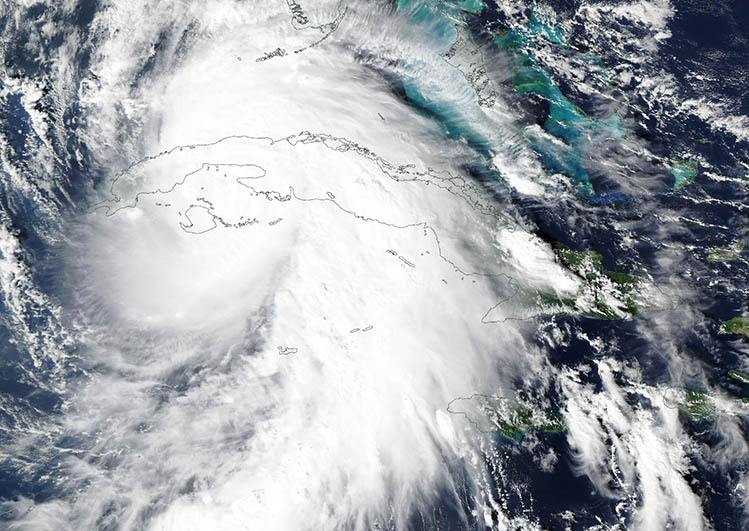Images
November 7, 2024 - Hurricane Rafael
Tweet
Hurricane Rafael made landfall just east of Playa Majana in the province of Artemisa, Cuba at 4:15 p.m. EST (2115 UTC) on November 6, 2024. The National Hurricane Center (NHC) advised the storm was carrying maximum sustained winds at landfall near 115 mph (185 km/h). This windspeed made it a Major Hurricane, and placed it in Category 3 on the Saffir-Simpson Hurricane Wind Scale.
Winds from Rafael knocked out Cuba’s power grid the day before landfall, leaving the entire population of about 10 million people without energy. Media reports that trees have been knocked down and the NHC warned to expect “life-threatening storm surge, damaging hurricane-force winds and flash flooding" across much of western Cuba as the storm passes across the island. The rain may trigger flash floods as well as landslides in the high terrain of western Cuba.
Hurricane Rafael comes only weeks after the failure of Cuba’s power grid late in October, near the time Hurricane Oscar made landfall over Cuba. It also hits when fruits and vegetables are ripening and the tobacco crop nears harvest, making the risk of serious economic damage to agricultural crops likely. The province of Artemsia is one of two that raises most of the valuable tobacco crop used for Cuba’s famous hand-rolled cigars.
The Moderate Resolution Imaging Spectroradiometer (MODIS) on NASA’s Aqua satellite acquired this true-color image of Hurricane Rafael just before landfall on November 6. Rafael’s cloud-filled center was located just off the southern shore of western Cuba and northeast of the Isla de la Juventude. Convective bands, carrying wind and heavy rain, reached northward to the Florida Keys and southward over the Cayman Islands and the tip of Jamaica.
By 7:00 p.m. EST on November 6 (0000 UTC on November 7), after less than 3 hours onshore, Hurricane Rafael had completed its sweep across Cuba and was moving into the Gulf of Mexico, according to the NHC. Life-threatening storm surge, damaging hurricane-force winds, and flash flooding were continuing over portions of western Cuba. Maximum sustained winds had reduced to 105 mph (170 km/h), which placed it as a Category 2 storm.
Hurricane Rafael is expected move northwest over the Gulf of Mexico through November 6, then slowly move west-northwestward as it traverses the Gulf of Mexico. Little change in strength is expected during the next day or so. Some models have Rafael becoming a tropical storm over the southern Gulf of Mexico by November 10, while still well away from land. The NHC advises that some tornadoes could be spawned over the Florida Keys and the southern tip of the Florida mainland November 6-7, and that heavy rain will continue across western Cuba, the Cayman Islands, and parts of the Caribbean at least through November 7.
Image Facts
Satellite:
Aqua
Date Acquired: 11/6/2024
Resolutions:
1km (313.2 KB), 500m (978.9 KB), 250m (2.7 MB)
Bands Used: 1,4,3
Image Credit:
MODIS Land Rapid Response Team, NASA GSFC
Tweet
Hurricane Rafael made landfall just east of Playa Majana in the province of Artemisa, Cuba at 4:15 p.m. EST (2115 UTC) on November 6, 2024. The National Hurricane Center (NHC) advised the storm was carrying maximum sustained winds at landfall near 115 mph (185 km/h). This windspeed made it a Major Hurricane, and placed it in Category 3 on the Saffir-Simpson Hurricane Wind Scale.
Winds from Rafael knocked out Cuba’s power grid the day before landfall, leaving the entire population of about 10 million people without energy. Media reports that trees have been knocked down and the NHC warned to expect “life-threatening storm surge, damaging hurricane-force winds and flash flooding" across much of western Cuba as the storm passes across the island. The rain may trigger flash floods as well as landslides in the high terrain of western Cuba.
Hurricane Rafael comes only weeks after the failure of Cuba’s power grid late in October, near the time Hurricane Oscar made landfall over Cuba. It also hits when fruits and vegetables are ripening and the tobacco crop nears harvest, making the risk of serious economic damage to agricultural crops likely. The province of Artemsia is one of two that raises most of the valuable tobacco crop used for Cuba’s famous hand-rolled cigars.
The Moderate Resolution Imaging Spectroradiometer (MODIS) on NASA’s Aqua satellite acquired this true-color image of Hurricane Rafael just before landfall on November 6. Rafael’s cloud-filled center was located just off the southern shore of western Cuba and northeast of the Isla de la Juventude. Convective bands, carrying wind and heavy rain, reached northward to the Florida Keys and southward over the Cayman Islands and the tip of Jamaica.
By 7:00 p.m. EST on November 6 (0000 UTC on November 7), after less than 3 hours onshore, Hurricane Rafael had completed its sweep across Cuba and was moving into the Gulf of Mexico, according to the NHC. Life-threatening storm surge, damaging hurricane-force winds, and flash flooding were continuing over portions of western Cuba. Maximum sustained winds had reduced to 105 mph (170 km/h), which placed it as a Category 2 storm.
Hurricane Rafael is expected move northwest over the Gulf of Mexico through November 6, then slowly move west-northwestward as it traverses the Gulf of Mexico. Little change in strength is expected during the next day or so. Some models have Rafael becoming a tropical storm over the southern Gulf of Mexico by November 10, while still well away from land. The NHC advises that some tornadoes could be spawned over the Florida Keys and the southern tip of the Florida mainland November 6-7, and that heavy rain will continue across western Cuba, the Cayman Islands, and parts of the Caribbean at least through November 7.
Image Facts
Satellite:
Aqua
Date Acquired: 11/6/2024
Resolutions:
1km (313.2 KB), 500m (978.9 KB), 250m (2.7 MB)
Bands Used: 1,4,3
Image Credit:
MODIS Land Rapid Response Team, NASA GSFC




